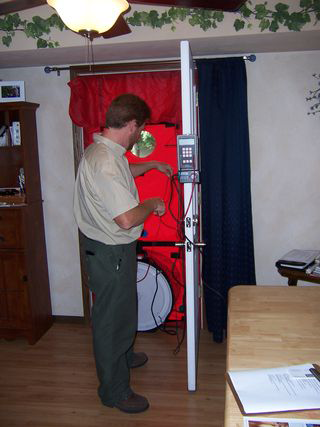
by blogediter | Sep 14, 2018 | Chimney Problems
Energy audit
Q: Jason, I have a wood burning fireplace with a cozy great heater insert. I have a top of the Chimney Balloon and traditional damper installed. I have bad downdrafts and soot smell on rainy, windy days.
I am a Home Inspector and I am in the middle of a Certified Energy Training Program with RESNET. I just received a copy of Energy Magazine and read about your product. Looks like a good idea. I am going to try the vinegar tip. I need to measure my flue and I will order to try on my house. Once I get my blower door I will try the test like you did. I have doors, 2 dampers, and the Chimney Balloon. Thanks.- MW
PS. I will tell all my clients if I have success with your product. Nice website by the way and I am posting it on a few inspection association boards for others to try.
A: Hi MW, That was a great article you were referring to in Home Energy magazine (Mar/Apr 09) the energy rater that did the testing of the Chimney Balloon (Mark Furst) for that article did a great summarizing his testing of the Chimney Balloon. Mark was chosen to do the review/test because he had no experience with the Chimney Balloon, and could give an unbiased opinion. Mark also has a great reputation in Wisconsin for being very thorough at energy rating. We cannot re-post the article for copyright reasons, but you can click here to see a PDF of a summary of the Chimney Balloon article.
We would really welcome your comments and test results if you decide to do your own blower door testing of the Chimney Balloon with your fireplace.
We have not had the opportunity yet to compare the Chimney Balloon to the top seal dampers in blower door testing. I know the top seal dampers tend to seal tighter than traditional low-in-the-firebox metal dampers, but the trouble that is often experienced with a top seal damper is you are sealing the Chimney Balloon and all of its creosote and soot content into the homes interior air envelope by bottling the chimney at the top. What further compounds the issue is the fact that the warm interior air that naturally ascends the Chimney Balloon and is trapped there by the top damper tends to cool against the uninsulated brick walls of the chimney and the cold metal of the top damper and then that now-cool air drops again to the firebox. This convection process and air movement creates a draft and odor sensation at the hearth and into the room. That could be what you are experiencing.
The Chimney Balloon installed low and close to the firebox seals of the chimney from the homes interior air and eliminates this convection and air movement. – Jason
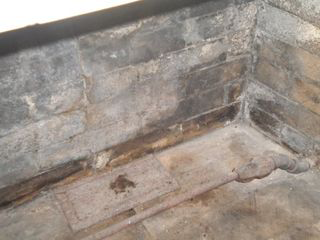
by blogediter | Aug 17, 2018 | Fireplaces
Q: Jason, We have been renovating an older home from the 70’s for quite some time and have just recently moved in. The problem is the drafty original brick fireplace. No unpleasant odors, just drafty cold air. We’ve done quite a bit to update the look, but now the beautifully tiled hearth is always cold as well as the entire room. (Even though we live in the South, our winters can get cold.)
We have resorted to putting a huge piece of cardboard in front of the firebox because we do not have any glass doors. It does seem to help but is not an acceptable permanent fix.
The damper does open and close but does not provide a good seal. There is an ash fire grate in the center of the firebox floor, from which I feel a small draft. The fireplace also had a gas “starter” which uses a key to turn the gas off and on (No pilot light). There is a good amount of draft coming from the opening around the key. This area does not seem, to be connected to the chimney or flu area so I don’t know if the Chimney Balloon would even help with this.
There appear to be some cracks in the fire bricks in the back of the fire box, which may also be contributing to the problem. Will the Chimney Balloon help? Do you think there are other things I could do to improve situation – glass doors, repair bricks… – DE
A: Dear DE, Since you just have a gas starter there you will be fine to use a Chimney Balloon as long as you make sure the gas is turned off completely with the key. Turning off the gas essentially is disabling the gas starter. Be certain though that the gas is completely shut off to the starter and you mark the key or gas tap with a note that the flue is plugged.
You have a few options of where to put the Chimney Balloon. If you have at least 8” of vertical lintel area below the damper handle you could put a Chimney Balloon in below the damper. If the damper is too low for that or the handle is in the way, you could also put a Chimney Balloon in just above the damper. Essentially you would open up the damper and use a folding carpenters ruler folded into an L shape to get a measurement up there. You would measure wall to wall from left to right and from front to back and that would tell you what size Chimney Balloon to get. The Chimney Balloon would rest right on top of the open damper.
Next, take a close look at the ash cleanout. You can remove the cover and measure the rough opening and install a Chimney Balloon into that ash chute. I am certain the majority of your draft is coming from air being exchanged between the ash chute and the chimney. This is a very common issue since and ash cleanout essentially is an air path that connects the basement or crawlspace to the chimney and results in a strong air pull through the fireplace that makes it cold.
After this, if you still have a draft coming from the keyhole, you can look into filling that with fireplace caulk if needed. – Jason
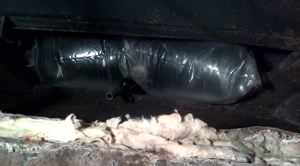
by blogediter | Jul 11, 2018 | Chimney Problems
Q: Jason, When I went to install my 9×15 small Chimney Balloon I got it in there a little sideways. Is it OK the way it is, or should I remove it and install it again? It is sealing tight and no more air is coming through. – EC
A: Dear EC, The Chimney Balloon is in there a little sideways. The handle valve should be coming straight out the Chimney Bottom of the Chimney Balloon through the old damper opening, but if it fills the void and stops the air passage that is the most important thing. It certainly won’t hurt anything to have it in the flue that way you have it. – Jason
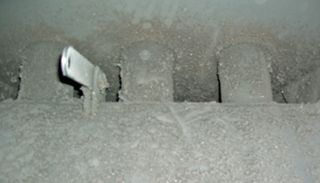
by blogediter | May 4, 2018 | Chimney Plugs
Heatilator
Q: Hi, I stumbled across your site today, and I am very interested in one of your Chimney Balloons. I have a question. My chimney has a system to take cold air off the floor in front of the hearth, and draw it through some pipes that run through the flue. This warm air is then fan forced out above the fireplace. The question is whether your Chimney Balloon will go between these pipes and the damper, or squeeze through between the pipes, and be inflated above them. I can take a digital picture and send or maybe take some measurements and send those… – CF
A: CF, Most people refer to those systems as heatilators (but that is a brand name.) A deflated Chimney Balloon needs a gap of 2″ to 2.5″ to fit through. Once you are through these pipes you should be good to go. I would suggest using a folding carpenters ruler to measure above the pipes so you can tell how large a Chimney Balloon you need. You may need to consider an extension for your Chimney Balloon if you plan on reaching very far past the heatilator pipes to inflate the Chimney Balloon. The Handle/valve Extender kit (HEK) will give you an extra 16″ of reach to add to your 12″ Chimney Balloon handle. You can see those extenders on the Buy Chimney Balloon page.
Below is an image of one and this is a link to the Chimney Balloon Blog entry on how to use the HEK Extender. http://www.chimneyballoonusa.com/blog/using_a_hek_extender/index.html
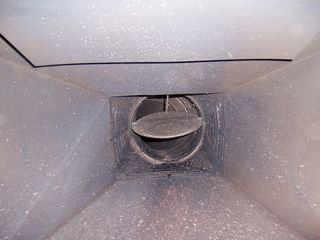
by blogediter | Apr 30, 2018 | Chimney Plugs
Flue Walls Slant
Q: Inside my fireplace, about 29″ up from above the opening is the damper. Just below the damper and each of the four sides or slit type openings. I do not know why. Maybe for air? I just saw the picture from SH and that is what mine likes like except all 4 sides slant in. It is about 10×10 at the damper. – KT
A: Dear KT, Since the sides slant on all 4 sides we will have to do the install high or low. We can use a HEK extender and a small 12×12 Chimney Balloon to install above the damper, or we can use the ledge that is generally just on the lintel and install a larger 36×15 Chimney Balloon. The lower install is easier but the balloon may be slightly visible from the room. _ Jason




